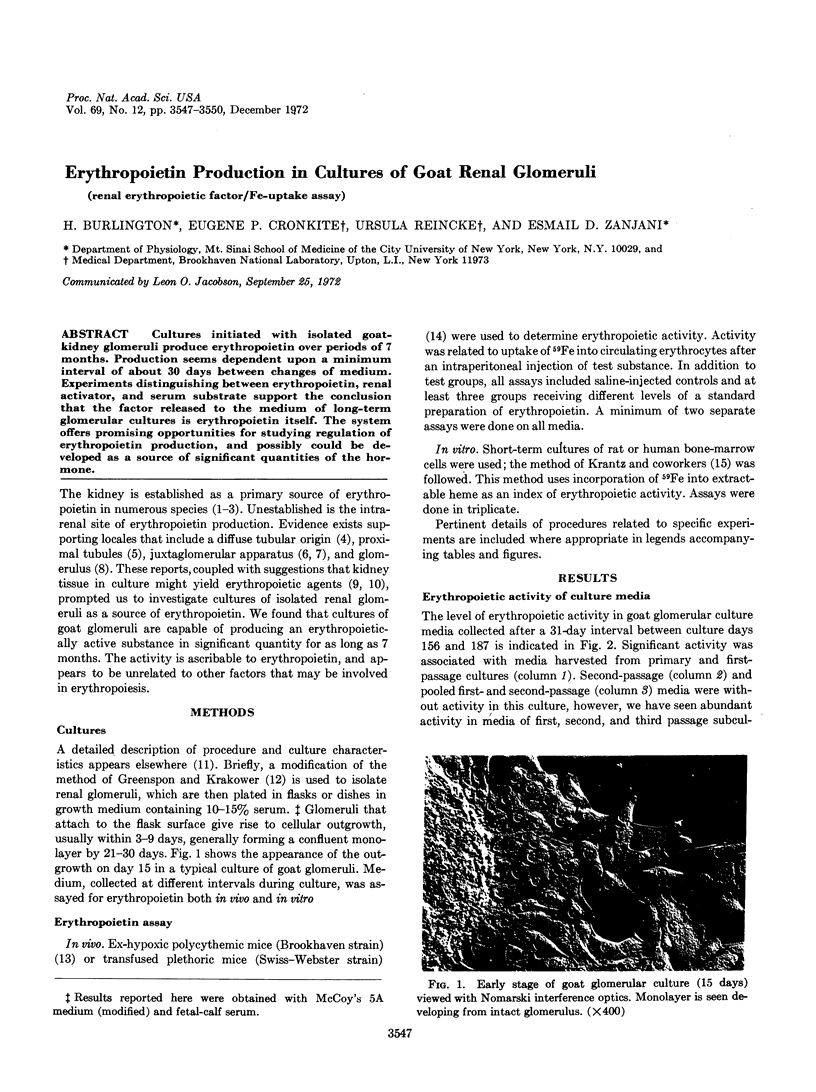Erythropoietin Production in Cultures of Goat Renal Glomeruli (original) (raw)
Abstract
Cultures initiated with isolated goat-kidney glomeruli produce erythropoietin over periods of 7 months. Production seems dependent upon a minimum interval of about 30 days between changes of medium. Experiments distinguishing between erythropoietin, renal activator, and serum substrate support the conclusion that the factor released to the medium of long-term glomerular cultures is erythropoietin itself. The system offers promising opportunities for studying regulation of erythropoietin production, and possibly could be developed as a source of significant quantities of the hormone.
Keywords: renal erythropoietic factor, Fe-uptake assay

Images in this article
Selected References
These references are in PubMed. This may not be the complete list of references from this article.
- Camiscoli J. F., Weintraub A. H., Gordon A. S. Comparative assay of erythropoietin standards. Ann N Y Acad Sci. 1968 Mar 29;149(1):40–45. doi: 10.1111/j.1749-6632.1968.tb15133.x. [DOI] [PubMed] [Google Scholar]
- FISHER J. W., KNIGHT D. B., COUCH C. The influence of several diuretic drugs on erythropoietin formation. J Pharmacol Exp Ther. 1963 Jul;141:113–121. [PubMed] [Google Scholar]
- GARCIA J. F., SCHOOLEY J. C. Immunological neutralization of various erythropoietins. Proc Soc Exp Biol Med. 1963 Mar;112:712–714. doi: 10.3181/00379727-112-28148. [DOI] [PubMed] [Google Scholar]
- GREENSPON S. A., KRAKOWER C. A. Direct evidence for the antigenicity of the glomeruli in the production of nephrotoxic serums. AMA Arch Pathol. 1950 Mar;49(3):291–297. [PubMed] [Google Scholar]
- GURNEY C. W., JACOBSON L. O., GOLDWASSER E. The physiologic and clinical significance of erythropoietin. Ann Intern Med. 1958 Aug;49(2):363–370. doi: 10.7326/0003-4819-49-2-363. [DOI] [PubMed] [Google Scholar]
- HIRASHIMA K., TAKAKU F. Experimental studies on erythropoietin. II. The relationship between juxtaglomerular cells and erythropoietin. Blood. 1962 Jul;20:1–8. [PubMed] [Google Scholar]
- Hartroft P. M., Bischoff M. B., Bucci T. J. Effects of chronic exposure to high altitude on the juxtaglomerular complex and adrenal cortex of dogs, rabbits and rats. Fed Proc. 1969 May-Jun;28(3):1234–1237. [PubMed] [Google Scholar]
- JACOBSON L. O., GOLDWASSER E., FRIED W., PLZAK L. Role of the kidney in erythropoiesis. Nature. 1957 Mar 23;179(4560):633–634. doi: 10.1038/179633a0. [DOI] [PubMed] [Google Scholar]
- KRANTZ S. B., GALLIEN-LARTIGUE O., GOLDWASSER E. THE EFFECT OF ERYTHROPOIETIN UPON HEME SYNTHESIS BY MARROW CELLS IN VITRO. J Biol Chem. 1963 Dec;238:4085–4090. [PubMed] [Google Scholar]
- LOWY P. H., KEIGHLEY G., BORSOOK H. Inactivation of erythropoietin by neuraminidase and by mild substitution reactions. Nature. 1960 Jan 9;185:102–103. doi: 10.1038/185102a0. [DOI] [PubMed] [Google Scholar]
- McDonald T. P., Martin D. H., Simmons M. L., Lange R. D. Preliminary results of erythropoietin production by bovine kidney cells in culture. Life Sci. 1969 Sep 15;8(18):949–954. doi: 10.1016/0024-3205(69)90199-4. [DOI] [PubMed] [Google Scholar]
- OSNES S. Experimental study of an erythropoietic principle produced in the kidney. Br Med J. 1959 Oct 10;2(5153):650–658. doi: 10.1136/bmj.2.5153.650. [DOI] [PMC free article] [PubMed] [Google Scholar]
- Sherwood J. B., Robinson S. H., Bassan L. R., Rosen S., Gordon A. S. Production of erythrogenin by organ cultures of rat kidney. Blood. 1972 Aug;40(2):189–197. [PubMed] [Google Scholar]
- Zanjani E. D., McLaurin W. D., Gordon A. S., Rappaport I. A., Gibbs J. M., Gidari A. S. Biogenesis of erythropoietin: role of the substrate for erythrogenin. J Lab Clin Med. 1971 May;77(5):751–758. [PubMed] [Google Scholar]